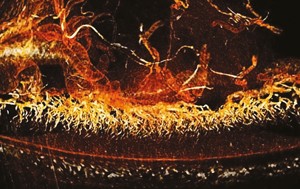Play all audios:
_Phys. Rev. Lett._ (in the press) Credit: © APS Fireflies light up summer nights using bioluminescence — a mechanism that is well understood from a biochemical point of view, requiring both
light-emitting luciferin and oxygen. But how do fireflies control their oxygen supply, and modify it to fuel flashing in addition to other biological functions? Without a microscopic map of
their respiratory system, it has been difficult to give a definitive answer. Yueh-Lin Tsai and colleagues used X-ray imaging to study the details of the firefly tracheal system and
discovered how the oxygen flow is switched on and off. Using high-resolution images (pictured), Tsai _et al_. identified the smallest branches of the trachea — the roughly
hundred-nanometre-long tracheoles — that are densely packed with mitochondria, which are organelles supplying energy to the cell. They estimated the oxygen diffusion rates and concluded that
during flashing, the activity of the mitochondria is reduced (most probably by the release of nitric oxide) and thus the oxygen flux needed for bioluminescence is increased. The firefly
lantern seems to be optimized for light emission: the flashing mechanism is very efficient, consuming considerably less energy than flying. Authors * Iulia Georgescu View author publications
You can also search for this author inPubMed Google Scholar RIGHTS AND PERMISSIONS Reprints and permissions ABOUT THIS ARTICLE CITE THIS ARTICLE Georgescu, I. Little lanterns. _Nature Phys_
11, 5 (2015). https://doi.org/10.1038/nphys3216 Download citation * Published: 23 December 2014 * Issue Date: January 2015 * DOI: https://doi.org/10.1038/nphys3216 SHARE THIS ARTICLE Anyone
you share the following link with will be able to read this content: Get shareable link Sorry, a shareable link is not currently available for this article. Copy to clipboard Provided by
the Springer Nature SharedIt content-sharing initiative

